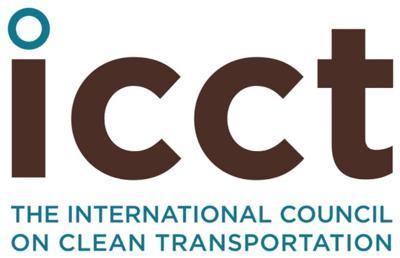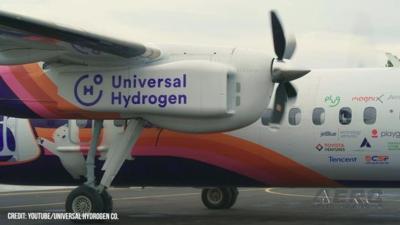Sweet Lucidity
A report newly set forth by the International Council on Clean Transportation (ICCT)—a Washington D.C.-based independent nonprofit providing technical and scientific analysis to environmental regulators—impugns the commercial applications of fuel-cell powered turboprop aircraft.

The ICCT contends hydrogen-electric fuel-cell-powered ATR and De Havilland Canada turboprops—specifically, ATR’s 72-600 and Bombardier’s (nee De Havilland’s) Dash-8 Q400—could have sufficient range to service most turboprop routes, but only when carrying many fewer passengers than the aircrafts’ respective design capacities.
Ergo, air-carriers utilizing turboprops retrofitted with hydrogen-electric powertrains, for which STCs have yet to be granted, would be obligated to operate vastly larger numbers of flights to meet extant market demand—were they aspired to turn a profit.
Released on 02 August, the ICCT’s report predicts, also, that the coming decades will see advancements in hydrogen fuel-cell technology conducive to increased power-generation, and a commensurate decline in hydrogen fueling costs. Moreover, the ICCT report posits fuel-cells utilizing liquid-hydrogen, which remains liquid only at temperatures colder than -423-degrees Fahrenheit, would provide greater range than those utilizing gaseous hydrogen.
The ICCT report states: “A fossil-fueled turboprop aircraft retrofitted with hydrogen storage and fuel-cell propulsion is more energy efficient and less carbon intensive, but more expensive to fuel. It would have lower payload and range capabilities but would reduce [greenhouse gas] emissions by 88-percent.”
Companies such as Universal Hydrogen and ZeroAvia are currently working to bring economically-viable hydrogen-electric aero-propulsion schemes to market. These concerns tout their so-called solutions as the aviation industry’s best hope for decarbonization.
ZeroAvia’s 804-horsepower (600-kilowatt) ZA600 powertrain has entered the second phase of prototype flight-testing in preparation for its planned 2025 FAA certification. Similarly, Universal Hydrogen’s Dash 8-300 test aircraft has successfully and repeatedly flown with one of its OEM turboprop engines replaced with a hydrogen-electric powertrain comprising Universal Hydrogen’s hydrogen fuel-cells and MagniX’s Magni650 electric propulsion unit.

The aforementioned successes notwithstanding, widespread adoption and implementation of hydrogen-electric powertrains remains fraught with colossal practical and infrastructural challenges.
In its report, the ICCT opines: “Retrofit fuel-cell aircraft will be a key testbed for hydrogen use in aviation where success would enable larger, clean-sheet aircraft to enter the commercial aviation market.”
Citing a fuel-cell retrofitted ATR 72 as a test case, the ICCT’s report addresses the range and (passenger) capacity limitations imposed by hydrogen-electric propulsion schemes. To wit: hydrogen’s energy-density is significantly lesser than that of conventional jet fuel, while its volume-per-energy-unit is four-times greater. Ergo, to actualize meaningful range, the cabin of a hydrogen-powered ATR 72 would need be stripped of large numbers of seats and fitted, instead, with sizable hydrogen storage tanks.
The ICCT’s report somewhat rhetorically states; “Carrying more hydrogen increases an aircraft’s maximum range, while reducing its passenger capacity.”
An OEM-correct ATR 72-600 powered by a pair of Pratt & Whitney Canada PW127 turboprops carries 78 passenger seats and has a range of 740-nautical-miles. By comparison, a liquid-hydrogen fuel-cell-powered ATR 72 carrying seventy passengers would have a range of less than 250-nautical-miles—so the ICCT states in its report. Only by removing 28 seats and installing hydrogen storage tanks in the resultant space could a fuel-cell retrofitted ATR 72 equal the range of its turboprop-powered OEM counterpart.
In light of capacity limitations, the ICCT concludes fuel-cell-powered aircraft could directly replace only 15 to twenty-percent of the aircraft servicing the 2023 turboprop market. Only by air-carriers adding large numbers of flights to existing routes could fuel-cell-powered aircraft replace the entirety of the global fleet of transport category turboprops.

The ICCT’s report also addresses green hydrogen, the high cost of which, the Council theorizes, stands to hinder the proliferation of hydrogen-electric aero-propulsion systems. The ICCT estimates the cost of fueling its hypothetical fuel-cell retrofitted ATR 72 with green hydrogen to be some forty-percent greater than the cost of petroleum jet fuel. The antecedent figures presuppose U.S. fuel costs in the year 2030. Unlike most gaseous hydrogen products, green hydrogen is produced via sustainable means.
According to the ICCT, green hydrogen purchased in Europe, where it is “expected to be more expensive to produce,” will likely command a price twice that of petroleum jet fuel in 2030, and fifty-percent greater in 2050. The ICCT’s fuel-cost predictions account for the expense of replacing fuel-cell systems, which are projected to require replacement every 3.5 years.
 Bolen Gives Congress a Rare Thumbs-Up
Bolen Gives Congress a Rare Thumbs-Up The SportPlane Resource Guide RETURNS!!!!
The SportPlane Resource Guide RETURNS!!!! Buying Sprees Continue: Textron eAviation Takes On Amazilia Aerospace
Buying Sprees Continue: Textron eAviation Takes On Amazilia Aerospace Hawker 4000 Bizjets Gain Nav System, Data Link STC
Hawker 4000 Bizjets Gain Nav System, Data Link STC Echodyne Gets BVLOS Waiver for AiRanger Aircraft
Echodyne Gets BVLOS Waiver for AiRanger Aircraft





